Exploring Scenarios In Sharp Practice – Part One: The American Civil War
October 24, 2017 by crew
Dylan @elessar2590 Asmus is kicking off a new series of articles focusing on Sharp Practice from Too Fat Lardies, a range of various time periods and battles showcasing different ways to enjoy your games and scenarios.
To kick things off we're going right to the end of the Sharp Practice book, the American Civil War.
Letting Your Imagination Run Wild
The most important thing to remember is that Sharp Practice is not a Historical Wargame. Well, it is, but it's not what most people think of when you say "Historical Wargame". Instead, Sharp Practice is a novel played out on the table.
There is no need to study before you play a game and no specific need to pick out the particular battle you want to play. You're free to let your imagination run wild and create some fantastic games using the rich history of your favourite period as a backdrop.
For this article series, I won't be picking some grand battle like Waterloo and zooming in on it. The games in this series are all of my own creation, using the scenarios provided in the Sharp Practice 2 rulebook with my own spin on them.
Sharp Practice is about the skirmishes and patrols of the period where one miniature really is one man. These scenarios are about making sure a bridge remains intact or breaking out a spy from prison while making a name for yourself and telling a great story.
These games focus on the small stuff you usually don't worry about, yet are vital. Is that bridge still intact? Did that powder supply arrive yet? Have we got any intelligence on that town we're moving into?
The Setting
Our scenario takes place during 1862 with the Confederate army under the newly assigned General Robert E. Lee heading to what will become the Battle of Antietam. The Union troops are on route to the main encampment when the scouts report that the enemy is nearby. At 'Warren's Farm' the two forces have met, both needing to open up the road for supplies, and the stage is set for our game.
The mission is simple, force the enemy to withdraw or rout while trying to keep as much of your own force (Company sized) intact as possible. The Union troops entered from a deployment point in one corner while the Confederates will be arriving from a deployment point in the opposite corner. The deck was shuffled and everyone was ready to get started.
Formulating A Plan
The Union Player knows he has the advantage of numbers so the plan is to fix the Confederates in the centre on one front while outflanking with the other and sweeping them from the side.
The Commander will advance on the Union left with three groups, with a reserve of two groups in the centre and another three groups on the opposite flank. The Skirmishers will try and get a few kills and possibly take out a leader with their improved chance of hitting.
The Confederate Player's plan is simple. Rush the enemy as fast as possible and even the odds. The Confederates will lose a long ranged shootout but if they can get off the first volley at close range and use their skirmishers to slow down any flanking attempt while the annon supports the advance they are in with a chance.
Positioning & Early Vollies
Both players first turns were spent getting men into position, with the Union flank slowed by terrain. The Skirmishers traded fire before the battle truly started.
The Union troops advanced to within close range of the Confederates whose commander used four cards to reactivate and take them out of the game for four turns while they rallied shock. The Confederates then reformed and charged the Union Skirmishers who were easily driven off but managed to kill the Confederate Leader before disengaging.
The centre saw the Confederate Infantry advance, covered by the Skirmishers, while the artillery got into position, but a random event triggered which meant that it only had one more round of shooting left for the game.
The Confederate's loaded canister and aimed their sights at the flanking Union troops, they knew that they had to save the shot until it would be most effective. The Skirmishers jumped the stone wall and ran to put fire on the now rallied Union Commander who had wiped out what was left of the Confederates on the flank.
Shock Factor
The Union reserve leader abandoned his men to assist the Commander in taking the shock off his troops, and thanks to a random event and some lucky dice rolling his men surged forwards, fired a volley and dealt a huge amount of damage to the Confederate Infantry.
Due to a lack of cards, the Confederate Artillery sat powerless as the Union Flankers came right up to the stone wall and fired a devastating volley, driving the Confederates back and leaving the Confederates with only a single point of force moral left.
The Confederate Skirmishers then fired once again into the Union Commander who was hit and killed bringing the Union force moral down to two points.
Critical Events
The new turn began with the Confederate Artillery finally delivered it’s devastating shot into the Union flank, causing a large amount of shock, but thanks to some very lucky rolls the Union men only took a single point of force moral.
It would all come down to the next activation, either the Confederate Skirmishers would break the Union centre or the reserves would break the Confederate centre. As it happened the next cards were a Union command card, followed by a Confederate Command card then a Union Command card.
Three command cards triggered a random event from the firing chart on the artillery piece. The dice were rolled and it turned out that the Union officer leading the flanking force had been hit by canister, not realised it, and was killed. With his death, the Union forces broke and fled.
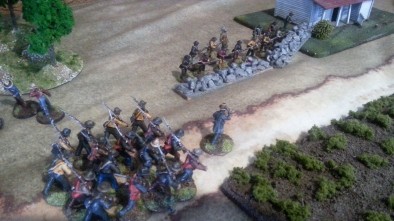
The American Civil War gives Sharp Practice a great backdrop with long range, quick loading rifles and troops being of less quality than earlier periods. Units still have to take an action to reload but in the earlier periods, a rifle needed two actions to reload which left riflemen very exposed and regulated to skirmishing.
This was especially important to the Confederates who needed to close the distance as quickly as possible or be torn apart from long range fire. In our game hey managed to do this but didn't take precautions and left their flanks open and vulnerable.
Command Cards
The card mechanics in Sharp Practice really help it stand out.
Each force has one dedicated card per leader and four 'Command Cards' each plus a single Tiffin card which make up the deck. Leaders activate and order their troops when their card is drawn.
Command Cards can be used to activate leaderless troops or enhance a unit and the Tiffin card ends the turn After the turn ends command cards can only be used to activate units that missed out during the turn so the timing of this can be crucial.
If three command cards are drawn in a row then the last unit to active has to roll for a random event which can range from an extra shooting action to a dead leader.
What really changed our game was the ability to reactivate a leader and his unit, the Confederate Commander was able to seize the initiative when the Union troops thought they were safe for the turn.
A random event then swung the game to the Confederates. You can never be sure that a unit is no longer a threat and you can never write off leaderless troops because the cards give the game a great random element.
Outcome
The engagement was bloody and very tense.
From the early death of a Status III Leader and his men's failure to take advantage of their situation, to a fluke cannister shot killing an officer and saving the Confederates from certain defeat.
While neither side completed their primary objective, by keeping their force in good order while driving off the enemy, the Confederates claimed a minor victory for routing the enemy.
The Confederates would probably have to spend the rest of the day tending to the wounded and getting reorganised so while they won the engagement they couldn't press their advantage, a common theme of civil war engagements.

True to the period half of all leaders were killed including both of the force Commanders and both sides were torn to pieces by close-range firefights as opposed to killed in the melee.
Stay tuned for my next article where we'll see if some brave American Patriots can rescue their allies from a makeshift British prison during the American War of Independence.
Post some comments below and let @Elessar2590 know what you thought.
If you would like to write an article for Beasts of War then please contact us at [email protected] for more information!
Supported by (Turn Off)
Supported by (Turn Off)
"The Confederates then reformed and charged the Union Skirmishers who were easily driven off but managed to kill the Confederate Leader before disengaging..."
Supported by (Turn Off)









































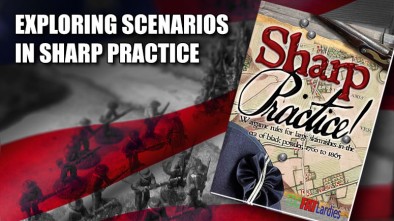
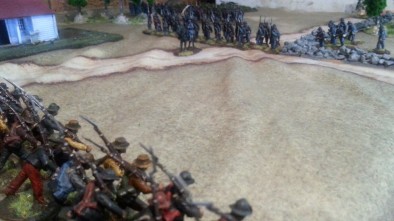
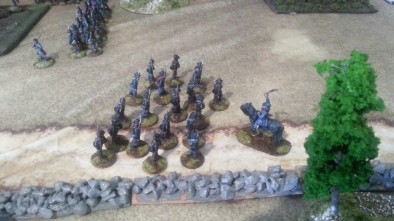
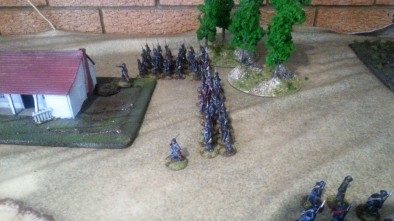


































Very nice and nice to see TFL games getting more coverage. You make an interesting point about it not being a historical game. I think a lot of players who don’t play historical game imagine them to be re fights of old battles with the same expected results. The truth I think is more than that. To me what they are is using historical minis with rules catering for the use of tactics of the time and using TOE’s of the time but there is plenty of space for what ifs and imaginary scenarios. In the end a skirmish game… Read more »
Thanks for the comment. I agree with you about, as the BOW guys would say, “Gaming in the Gaps” and this is hands down (for me) the best system to do that with. Re-fighting big battles can be great and all my stuff has sabot bases so I can do it but I prefer to do the smaller fights where you can really make a story come alive.
Awesome! Glad to see @elessar2590 putting out another article series. 😀 I Still remember the one you did on the French and Indian War.
Thanks @oriskany. Hope you enjoy the series
Absolutely. Anytime historical is on the front page I am happy. 😀
Very nice report and great to see Sharp Practice getting some airtime on BOW. It’s a brilliant set of rules which never fail to produce interesting games whatever period you play.
You may already do this but can I recommend taking time to name the Leaders in your force. It really helps draw players into the narrative even in one off games in my experience. You don’t need to flesh out the character, but simply naming him makes a positive difference I find.
Thanks for the comment. I played around with the idea but couldn’t squeeze it in although I will be naming Leaders for the Napoleonic Article and the last article in the series is going to break down how to create names and personalities for your leaders.
Great stuff, it might not be a historic simulation – but who cares when the dice roll and the minis move?
Alas I only got to play one game of sharp practice before I lost my book in a house move but it’s such a good system and doesn’t require hundreds of minis that other systems use
Thanks for taking the time out to produce another article series @elessar2590. The story based scenario sort of got pushed to the background for a while in favour of points based pick up games. So it is good to see it is making a comeback. Even FoW V4 had added a Fog of War card deck and command decks of cards to the nationalities that can bring the element of the unexpected. TFL rulesets that I have seen are quite good and have a strong focus on command and control. So at company level is this game aimed at 15mm… Read more »
It’s designed for 28mm but I think it could easily be adapted, the book states between 20-100 miniatures but could easily be adapted for more (using multiple force moral charts for different brigades) The game really pushes for a more narative approach to games (it works as just a shooting match but a narative scenario fits better) the command deck has specific rules for changing a “chapter ” in the game where reinforcements can turn up or even expand the game board. Tfl have released more rules for campaigns customising officers and there are several free army lists for different… Read more »
Most of the pictures in the book are of 28mm miniatures but the actual groundscale is a match for 15mm. You can use 15, 20 or 28mm figures with no difficulty. I use 15mm for ACW and 28mm for FIW and Napoleonics because that what I had in my collection.
Figure to Men ratio can be anything from 1:1 to 1:5, it’s your choice. So with typically 50-60 figures in a game you can represent anything from say half a company to 2-3 companies depending on period or setting.
Thanks for the Comments guys. My minis are 28mm Perry American Civil War Miniatures but you can use anything you like, there’s even a 6mm Conversion chart. This is Company level but to me it’s better to think of it as “The level of troops you see in an episode of Sharpe”. So around 50-100 men. The French Indian War Army Lists are smaller than the later American Civil War lists and there’s even a “Literary Detachment” for the Napoleonic Period with lots of Riflemen. This was just a straight up “shoot and kill” game but the next few articles… Read more »
will the thin red? line hold the dice GODS will decide.
If anyone is at Crisis in Antwerp next weekend, the whole Lardy team will be there running games of Sharp Practice and Chain of Command.
Great Civil War material! The story aspect is important.
Dota 2 skin betting has been popular since its video game release. It attracts many customers not only for playing an excellent game itself but also because it features large numbers of tournaments and leagues. This reason generates an abundance of betting interest for esports enthusiasts. However, http://dota2bets.me/dota-2-coinflip what makes Dota 2 skin betting best among other esports is its aspect of allowing users to use skins or items for betting aside from real money.